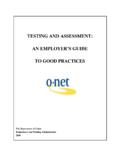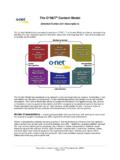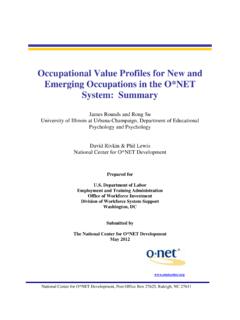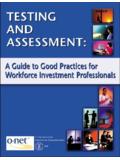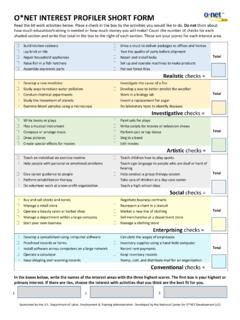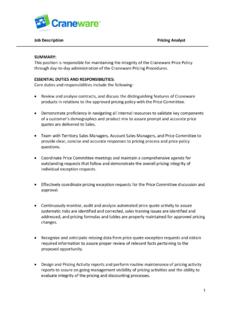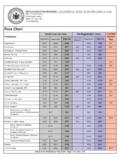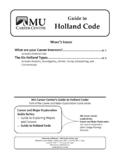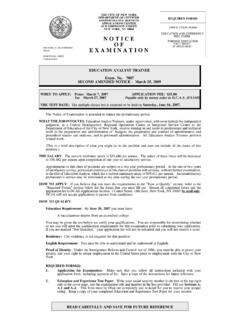Transcription of O*NET Analyst Occupational Skill Ratings: Procedures
1 FR-08-70 O*NET Analyst Occupational Skill ratings : Procedures Suzanne Tsacoumis Shannon Willison Prepared for: National Center for O*NET Development North Carolina O*NET Center 700 Wade Avenue Raleigh, NC 27605 March 2010 Human Resources Research Organization (HumRRO) i O*NET Analyst Occupational Skill ratings : Procedures Executive Summary The Occupational Information Network ( O*NET ) is a comprehensive system developed by the Department of Labor that provides information for 965 occupations within the economy. This information is maintained in a comprehensive database, developed to replace the Dictionary of Occupational Titles (DOT) ( Department of Labor, 1991). In order to keep the database current, the National Center for O*NET Development is involved in a continual data collection process aimed at identifying and maintaining up-to-date information on the characteristics of workers and jobs. In order to ensure a controlled data collection and management process, Occupational data is being collected in groups or cycles of approximately 100 occupations.
2 Most of the Occupational information is collected from job incumbents, including: Occupational tasks, generalized work activities, knowledge, education and training, work styles, and work context areas. Occupational analysts provide the importance and level information regarding the abilities and skills associated with these occupations. This report describes the Procedures used to collect the Occupational Analyst ratings on the 35 Skill constructs, which mirror the Procedures established for collecting ability ratings as described in O*NET Analyst Occupational Abilities ratings : Procedures (Donsbach, Tsacoumis, Sager, & Updegraff, 2003). To facilitate the Skill ratings , relevant Occupational information was developed from recent data collected from job incumbents. This information was provided to Occupational analysts to help them make Skill level and importance ratings . Specifically, Occupational analysts received the: Title and definition of the occupation Job zone of the occupation ( , level of vocational preparation needed) Mean importance of core and supplementary tasks for the targeted occupation Mean importance of knowledge domains that have a mean importance > Mean importance of Generalized Work Activities (GWAs) that (1) have a mean importance for the occupation > , and (2) require the targeted Skill to be performed Mean rating of Work Context (WC) statements that (1) have a mean ratings for the targeted occupation > , and (2) require the targeted Skill to work in that context Following the development of the Occupational information, 16 Occupational analysts were selected as raters based on criteria related to education and work experience.
3 These Occupational analysts were trained to interpret the Occupational data and make importance and level ratings of the skills . Following standardized Procedures to review the Occupational information, the trained Occupational analysts completed the rating process. Occupational analysts performance and ratings were monitored and evaluated throughout the project. If necessary, remedial training and guidance were provided. Final importance and level ratings for each occupation were delivered to the National Center for O*NET Development. Human Resources Research Organization (HumRRO) ii O*NET Analyst Occupational Skill ratings : Procedures Table of Contents Executive Summary .. i 1 Skill Rating Process .. 3 Tasks .. 4 Knowledge .. 4 Generalized Work Activities (GWAs).. 5 Work Context Descriptors .. 6 Skill /GWA and WC Linkages .. 6 Skill Rating 7 Stimulus Material Development .. 8 Occupation Title, Definition, and Job 8 Tasks .. 8 Knowledge .. 8 Generalized Work 9 Work Context Statements.
4 9 Occupational Analysts .. 9 Occupational Analyst 10 Occupational Analyst Training .. 10 Experienced Occupational Analyst Training .. 11 Data Collection .. 11 Rating Schedule and 11 Disseminating Stimulus Materials .. 12 Recording the 12 Rating Analysis .. 13 Batch Analysis .. 13 Cycle Analysis .. 13 Summary .. 15 16 Appendix A Skill Definitions by A-1 Appendix B - Job Zone B-1 Appendix C Knowledge Domain C-1 Appendix D - Linkage Exercise: Participant Instructions .. D-1 Appendix E - Generalized Work Activity and Work Context Linkage Results ..E-1 Human Resources Research Organization (HumRRO) iii Appendix F - Rating F-1 Appendix G - Sample Stimulus G-1 List of Tables Table 1. General Batch 12 List of Figures Figure 1. O*NET Analyst Data Collection 2 Human Resources Research Organization (HumRRO) 1 O*NET Analyst Occupational Skill ratings : Procedures Introduction The Occupational Information Network ( O*NET ) is a comprehensive system developed by the Department of Labor that provides information for 965 occupations within the economy.
5 This information is maintained in a comprehensive database, developed to replace the Dictionary of Occupational Titles (DOT) ( Department of Labor, 1991). In order to keep the database current, the National Center for O*NET Development is involved in a continual data collection process aimed at identifying and maintaining current information on the characteristics of workers and jobs. The information that populates the O*NET database is collected from three primary sources: incumbents, Occupational experts, and Occupational analysts. Targeted job incumbents provide ratings on Occupational tasks, generalized work activities (GWA), knowledge, education and training, work styles, and work context areas. Importance and level information regarding the abilities and skills associated with these occupations is collected from Occupational analysts. Although Skill information initially was collected from job incumbents, recent research suggests that trained Occupational analysts understand the Skill constructs better than incumbents (Morgeson & Campion, 1997; Tsacoumis, 2007), and therefore it follows that they should provide the Skill data.
6 In these instances, it is imperative that the Occupational analysts have detailed occupation information in order to rate the Skill constructs. It has also been suggested that incumbents are more likely than analysts to deliberately inflate their ratings to influence policy decisions such as those associated with compensation and training (Harvey, 1991; Morgeson, Delaney-Klinger, Mayfield, Ferrara, & Campion, 2004). Skill ratings may be particularly vulnerable to such effects given that they are more abstract and thus more difficult to verify than more observable descriptors such as job tasks (Morgeson & Campion, 1997; Morgeson et al., 2004). Given these considerations, Occupational analysts as opposed to incumbents provided the Skill information in the O*NET database. skills are proficiencies that are developed through training or experience. The 35 skills in the O*NET database are grouped into seven categories: content, process, social, complex problem solving, technical, systems, and resource management (see Appendix A).
7 To facilitate the Skill rating process, Occupational analysts are provided relevant Occupational information from incumbents. The purpose of this report is to describe the entire Analyst data collection process, from preparation of the materials describing Occupational data to analysis of the final Skill ratings . A flow diagram of this process is presented in Figure 1. It should be noted that to ensure a controlled data collection and management process, Occupational data are being collected in groups or cycles. This report describes the data collection process that generalizes across all 965 occupations. These Procedures are nearly identical to those described in O*NET Analyst Occupational Abilities ratings : Procedures (Donsbach, Tsacoumis, Sager, & Updegraff, 2003), with only minor modifications to streamline the process. Human Resources Research Organization (HumRRO) 2 Figure 1. O*NET Analyst Data Collection Process Prepare Stimulus MaterialsPrepare Stimulus MaterialsSelect AnalystsSelect AnalystsTrain AnalystsTrain AnalystsDistribute Stimulus MaterialsDistribute Stimulus MaterialsCollect RatingsCollect RatingsProvide Analyst FeedbackProvide Analyst FeedbackAnalyze DataAnalyze DataCreate FinalDatabaseCreate FinalDatabaseReceive New Incumbent DataReceive New Incumbent Data Human Resources Research Organization (HumRRO) 3 Skill Rating Process As noted above, the Skill rating process followed the Procedures that were previously established to rate abilities.
8 Similar considerations were given to the development of the rating process and stimulus materials. The ultimate goal in developing the stimulus material was to identify the data that would provide sufficient information about the occupation as a whole so the Occupational analysts can make accurate Skill importance and level ratings . At the same time, it was important to balance the desire to present all available information with the possibility of overwhelming the Occupational analysts with more data than can be reasonably processed. Based on a review of the O*NET Content Model (Peterson, Mumford, Borman, Jeanneret, Fleishman, 1995; Peterson, Mumford, Borman, Jeanneret, Fleishman, & Levin, 1997; Peterson, Mumford, Borman, Jeanneret, Fleishman, 1999), it was determined that the following information available in the O*NET database would be informative for the Occupational analysts and was included in the stimulus materials: Title, definition, and job zone of the occupation Task statements and data Knowledge statements and data Generalized Work Activity (GWA) statements and data Work Context items and data These pieces of information offer a comprehensive description of the occupation and provide insight about how the skills may be applied on the job.
9 In contrast, the other domains (work styles) were not deemed to provide critical information required to make judgments about the importance or level of the skills to an occupation. Note Job Zone information was included in the stimulus materials to describe occupations beginning in Cycle 9. Job zone is a classification system that describes the amount of preparation that can lead to successful job performance (National Center for O*NET Development, 2008). Occupations are sorted into five job zones based on similar levels of vocational preparation (Appendix B). The O*NET center, HumRRO, and Occupational analysts agreed that providing job zone information would assist in understanding the scope of different occupations. The presentation of occupation title, definition, and job zone is straightforward. In contrast, there are a number of different pieces of information that could be presented for the tasks, knowledge statements, GWAs, and Work Context items. For example, incumbents provide a variety of ratings ( , importance, frequency, level) for tasks, knowledge statements, GWAs, and Work Context items.
10 Given this, the next step was to determine what data, specifically, would be included in the stimulus materials to facilitate the Occupational Analyst rating process. The issues and final decisions associated with each key piece of Occupational information included in the stimulus materials are presented on the following pages. Human Resources Research Organization (HumRRO) 4 Tasks A task is defined as an activity that occurs in order to produce a product or outcome required on the job (Peterson, et al., 1999). In reviewing the options for what task data should be presented, it was determined that it would be meaningful for the Occupational analysts to be aware of the importance associated with each task, although frequency and relevance were deemed less informative. With regard to importance, it seemed insufficient to provide a list of the important tasks, without a clear understanding of the degree to which each task was important to the specific occupation.
